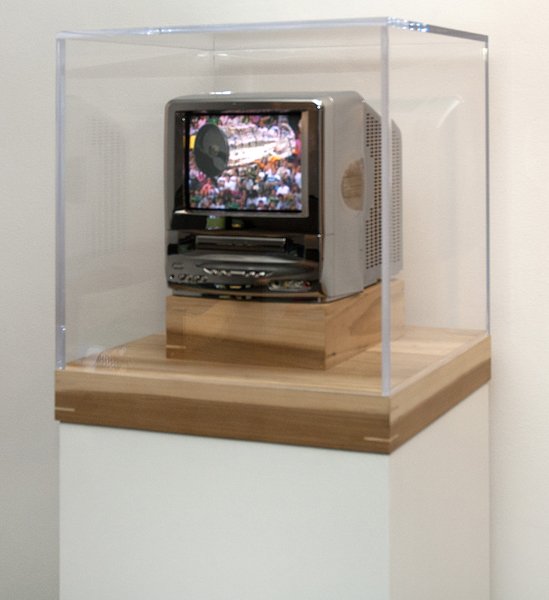A New Installation by Paul Pfeiffer
Sunday, January 1, 2006

Paul Pfeiffer (American, born 1966). Caryatid, 2003. Digital video loop, chromed nine-inch color television, DVD player, Plexiglas case on pedestal, edition 5/6, 20 x 20 x 20 inches (50.8 x 50.8 x 50.8 cm). Collection Albright-Knox Art Gallery, Buffalo, New York; Sherman S. Jewett Fund, by exchange and Gift of Dennis and Debra Scholl, 2010 (2010:3a-c). © Paul Pfeiffer.
In recognition of the Stanley Cup’s visit to Buffalo on April 24, 2006, the Albright-Knox exhibited Pfeiffer’s work Caryatid, 2003, honoring hockey’s Holy Grail. In Caryatid, Pfeiffer presents video footage of the Cup, as it is held up above the heads of players of winning hockey teams; but by erasing the players, Pfeiffer alters our perception of hockey’s highest symbol of achievement. Here, the massive cup floats alone above the crowd, evoking thoughts of a toy space rocket or R2-D2. Inscribed each year with the names of winning players, coaches, managers, and club staff, the Stanley Cup is the most famous of all sports trophies—a celebrity in its own right. Winning the Stanley Cup is a dream of every aspiring hockey player. Pfeiffer’s manipulation of this footage not only illustrates the Cup’s status as a symbol of a spiritual quest but also meditates on the complicated ways in which faith and desire unfold in contemporary culture.
The title of this work refers to the sculpted support structures of ancient Greek temples. In fact, four caryatids are featured in the architectural design of the Albright-Knox’s original building by Edward B. Green, who adopted the Greek revival style for this project. It is in the ghostly remains of the hockey players where Pfeiffer makes this architectural reference to antiquity.
Paul Pfeiffer is heralded as one of the most important emerging American artists of our time for his thought-provoking, playful, and often surprising manipulation of video. The sports event is a favorite subject of Pfeiffer’s, and he describes his relationship to this spectacle of sports as one of “director, spy, and fan.” He is drawn to the intense displays of emotion, the pageantry, the sensory overload, and simply, the sheer magic of the sports experience. Yet, Pfeiffer is also aware that our media-saturated environment shapes our consciousness. His manipulation of footage from professional sporting events, including basketball, boxing, and hockey, illustrates how images and technology are transformative. Images, such as the image of the sports event here, offer moments when one can escape the mundane through an engagement with a fantastic world of entertainment. Yet, images and technology are so omnipresent in contemporary society that many believe they have completely altered who we are.
Seymour H. Knox, Jr., and his family have been important patrons of the Albright-Knox since 1925, and they were also instrumental in bringing a National Hockey League franchise to Buffalo in 1969. Northrup R. Knox and Seymour H. Knox III were founding members of the Buffalo Sabres organization and served as key members for many years. As the playoffs approach, the long tradition of the Stanley Cup continues.
This exhibition was organized by Associate Curator of Contemporary Art Claire Schneider.

